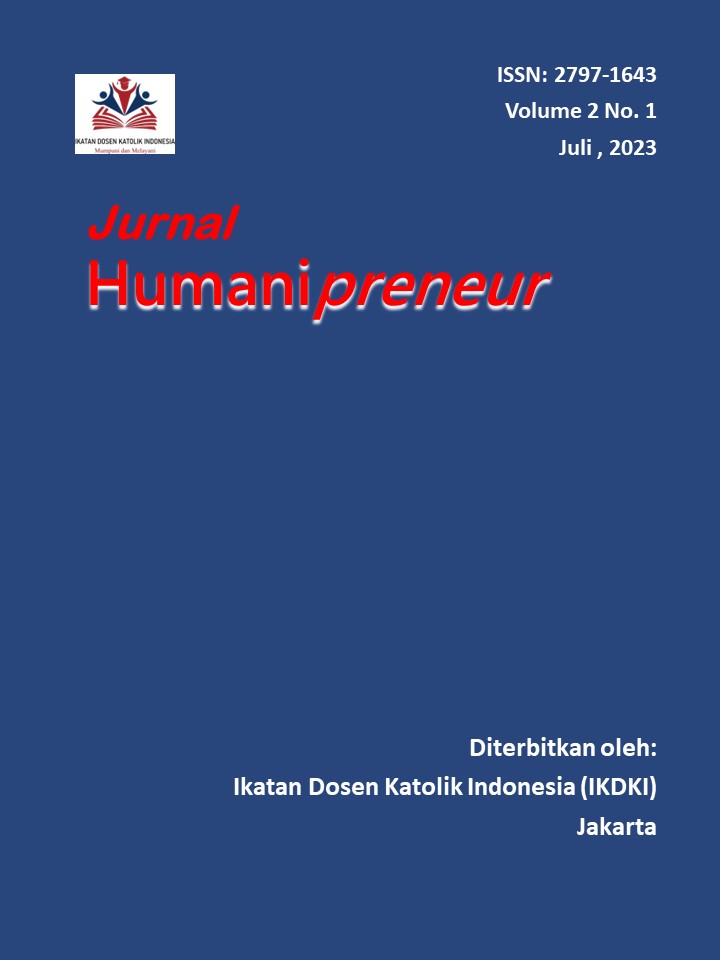Intensitas Penggunaan TikTok dan Self-Esteem: Studi pada Dewasa Awal
DOI:
https://doi.org/10.53091/hum.v2i2.40Keywords:
intensitas penggunaan TikTok, self-esteem, young adultAbstract
Penelitian ini bertujuan untuk menguji pengaruh intensitas penggunaan TikTok terhadap self-esteem dewasa awal di Indonesia. Penelitian ini diikuti oleh 123 pengguna TikTok berusia antara 18 sampai 25 tahun. Penelitian ini menggunakan metode cross-sectional predictive correlational untuk menguji hipotesis penelitian. Terdapat dua alat ukur yang digunakan, yaitu: (a) The Facebook Intensity Scale yang diadaptasikan dalam konteks penggunaan TikTok, dan (b) Rosenberg Self-Esteem Scale. Hasil dari analisis regresi linear menunjukkan bahwa intensitas penggunaan TikTok secara signifikan meningkatkan self-esteem dewasa awal. Implikasi dari temuan penelitian didiskusikan dalam tulisan.
References
We Are Social, “The global state of digital in April 2023,” We Are Social, 2023. .
L. Ceci, “Distribution of TikTok users worldwide as of April 2023, by age and gender,” Statista, 2023. .
E. A. Vogel, J. P. Rose, L. R. Roberts, and K. Eckles, “Social comparison, social media, and self-esteem.,” Psychol. Pop. Media Cult., vol. 3, no. 4, pp. 206–222, Oct. 2014, doi: 10.1037/ppm0000047.
S. Jiang and A. Ngien, “The effects of Instagram use, social comparison, and self-esteem on social anxiety: A survey study in Singapore,” Soc. Media Soc., vol. 6, no. 2, 2020, doi: 10.1177/2056305120912488.
P. M. Valkenburg, M. Koutamanis, and H. G. M. Vossen, “The concurrent and longitudinal relationships between adolescents’ use of social network sites and their social self-esteem,” Comput. Human Behav., vol. 76, pp. 35–41, Nov. 2017, doi: 10.1016/j.chb.2017.07.008.
A. Masciantonio, D. Bourguignon, P. Bouchat, M. Balty, and B. Rimé, “Don’t put all social network sites in one basket: Facebook, Instagram, Twitter, TikTok, and their relations with well-being during the COVID-19 pandemic,” PLoS One, vol. 16, no. 3, p. e0248384, Mar. 2021, doi: 10.1371/JOURNAL.PONE.0248384.
E. Leimonis and K. Koutra, “Social media sse and mental health in young adults of Greece: A cross-sectional study.,” Clin. Psychol. Eur., vol. 4, no. 2, p. e4621, Jun. 2022, doi: 10.32872/cpe.4621.
N. B. Ellison, C. Steinfield, and C. Lampe, “The benefits of Facebook ‘friends:’ Social capital and college students’ use of online social network sites,” J. Comput. Commun., vol. 12, no. 4, pp. 1143–1168, Jul. 2007, doi: 10.1111/j.1083-6101.2007.00367.x.
M. Rosenberg, Society and the adolescent self-image. Princeton University Press, 1965.
H. Mieczkowski, A. Y. Lee, and J. T. Hancock, “Priming effects of social media use scales on well-being outcomes: The Influence of intensity and addiction scales on self-reported depression,” Soc. Media + Soc., vol. 6, no. 4, p. 205630512096178, Oct. 2020, doi: 10.1177/2056305120961784.
L. M. J. Rahma and S. Setiasih, “The impact of social media usage intensity on self-esteem: Survey on emerging adulthood of Instagram user,” KONSELI J. Bimbing. dan Konseling, vol. 8, no. 1, pp. 39–46, 2021, doi: 10.24042/kons.v8i1.8313.
B. Trifiro, “Instagram use and its effect on well-being and self-esteem,” Bryant University, 2018.
M. Á. Pertegal, A. Oliva, and A. Rodríguez-Meirinhos, “Development and validation of the Scale of Motives for Using Social Networking Sites (SMU-SNS) for adolescents and youths,” PLoS One, vol. 14, no. 12, 2019, doi: 10.1371/journal.pone.0225781.
F. I. R. Dewi and M. P. Sari, “Motivation for Instagram use, passive Instagram use and fear of missing out (FoMO),” J. Komun., vol. 14, no. 1, p. 251, 2022, doi: 10.24912/jk.v14i1.18592.
Downloads
Published
How to Cite
Issue
Section
License
Copyright (c) 2023 Reynaldo Reynaldo, Meylisa Permata Sari

This work is licensed under a Creative Commons Attribution-ShareAlike 4.0 International License.









